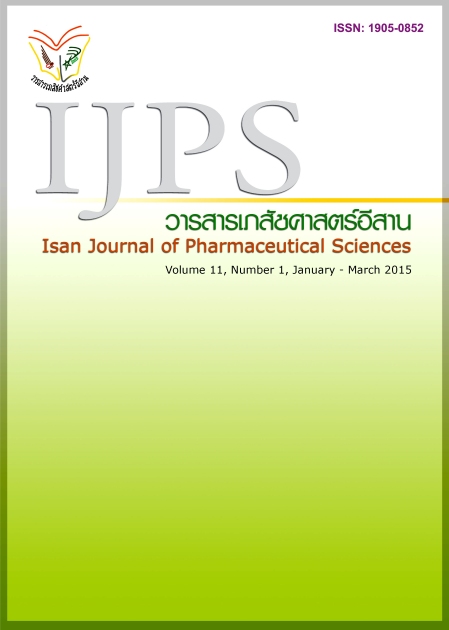Antioxidant and Antibacterial Activities of Grape Seed and Peel Extracts
Main Article Content
Abstract
Grape pomace, which is a waste material in grapes, is a rich source of phenolic compounds, and has been reported to contain natural antioxidants and antimicrobial agents. The objectives of this research is to provide a quantitative analysis of the total phenolic contents from red grape peel and seed extracted using 3 different solvents: water at pH 3, ethanol and acetone. The extracts were tested for antioxidant activities and anti-bacterial action against Staphylococcus aureus, Staphylococcus epidermidls, Bacillus subtilis, and Escherichia coli Methods: A quantitative analysis of the total phenolic contents from grape seed and peel extracts with water at pH 3, ethanol and acetone were conducted. Their antioxidant activities, including free radical scavenging capacity using Diphenly-1-picrylhydrazyl (DPPH), Lipid peroxidation, Ferric ion Reducing Power Assay (FRAP) and antimicrobial activity were tested by using the broth dilution method and agar diffusion assay. Results: Seed and peel extracted with water at pH 3 gave the highest percent yield (%w/w, dry weight) of 10.032 ± 0.104 and 8.873 ± 0.144, respectively. The ethanolic extracts of grape seeds and peels contained the highest of total phenolic compounds of 34.20 ± 0.001 and 32.16 ± 0.00 milligram gallic acid equivalents/ gram dry weight sample, respectively. The ethanolic extract from grape seed showed the highest antioxidant activity. In addition, the IC50 correlated with the total phenolic compounds. The effectiveness of antibacterial activity in descending order was B. subtilis, E. coli, S. aureusand, S. epidermidis. Conclusion: Grape seed and peel extracts appeared to have the potential antioxidant action and antibacterial activity against some bacterial pathogens.
Article Details
In the case that some parts are used by others The author must Confirm that obtaining permission to use some of the original authors. And must attach evidence That the permission has been included
References
Bao J, Cai Y, Sun M, Wang G, Corke H. Anthocyanins, flavonoids and free radical scavenging activity on Chinese bayberry (Myricarubra) extracts and their color properties and stability. J Agri Food Chem. 2005; 53: 2327-32.
Guerrero RF, Liazid 1 Palma M, Puertas . Barrio G, Gil-Izquierdo A, et al., Phenolic characterization of red grapes autochthonous to Andalusa. Food Chem. 2009; 112: 949-955.
Huang DJ, Ou BX, Prior RL. The chemistry behind antioxidant capacity assays. J Agri Food Chem. 2005; 3(6): 1841-56.
Jayaprakasha GK, Selvi T, Sakariah KK, Antibacterial and antioxidant activities of grape (Vitis vinifera) extracts. Food Res Inter 2003; 36: 117-122.
Katalinic V, SmoleMozina S, Skroza D, Generalic I, Abramovic H, Milos M, et al. Polyphenolic profile, antioxidant properties and antimicrobial activity of grape skin extracts of 14 Vitis vinifera varieties grown in Dalmatia (Croatia). Food Chem. 2010; 119: 715-23.
Kim DO, Lee CY. Extraction and isolation of polyphenolics. Current Protocols in Food Analy tical Chemistry. R.E. Wrolstad. New York; Wiley. 2002.
Kim TJ, Silva JL, Weng WL, Chen w w , Corbitt M, Jung YS, et al., In a c tivation of Enterobactorsakazakii by water-soluble muscadine seed extracts. Inter J Food Microbio. 2009; 129: 295-299.
Lee JH, Talcott ST, Fruit maturity and juice extraction influences ellagic acid derivatives and other anti oxidantpolyphenolics in muscadine grapes. Food Chem. 2004; 52: 361-366.
Malovana S, Montelongo FJG, Rodriguez-Delgado MA, Optimisation of sample preparation for the determination of trans-resveratrol and other poly phenolic compounds in wines by high performance liquid chromatography. Analy chim Acta. 2001; 428: 245-253.
Microbial population count [online]. 2010 Dec 31 [cited 2013 Dec 1]. Available from: http://science.kmutt.ac.th/class/mic291/mic291lab7.doc
Passos CP, Yilmaz S, Silva CM, Coimbra MA, Enhancement of grape seed oil extraction using a cell wall degrading enzyme cocktail. Food Chem. 2009; 115: 48-53.
Poudel PR, Tamura H, Kataoka I, Mochioka R. Phenolic compounds and antioxidant activies of skin and seeds of five wild grapes and two hybrids native to Japan. J Food Comp Ana. 2008; 21: 622-5.
Rafaela GM, Gloria LM, Monica G, Antioxidant activity in banana peel extracts: Testing extraction conditions and related bioactive compounds. Food Chem. 2010; 119: 1030-1039.
Rupasinghe V, Clegg HPS, Total antioxidant capacity, total phenolic content, mineral elements and histamine concentration in wines of different fruit sources. J Agri Food Chem. 2007; 40: 210-15.
Shoko T, Soichi T, Megumi MM, Erl F, Jun K, Michiko W. Isolation and Identification of an antibacterial compound from grape and it application to food . Nippon NogeikagakuKaishi. 1999; 73: 125-8.
Stalikas CD. Extraction, separation, and detection methods for phenolic acids and flavonoids. J Sep Sci. 2007; 30(18): 3268-95.
Torrungruang K, Vichienroj P, Chutimaworapan S, Antibacterial activity of mangosteen pericarp extract against cariogenic Streptococcus mutans. Chula Univ Dent. 2007; 30:1-10.
Vatterm DA, Lin YT, Shetty LK. Antimicrobial activity against select food-boms pathogens by phenolic antioxidants enriched in cranberry pomace by solid-state bioprocessing using the food grade fungus Rhlzopus oligosporus. Proc Biochem. 2004; 39: 1939-46.
Vine RP. Commercial Wine making, Process and Control. London: Chapman and Hall; 1981.
Xu c , Yali z, LeiC, Jiang L. Phenolic compounds and antioxidant properties of different grape cultivars grown in China. Food Chem. 2010; 119(4): 1557-65.
Yilmaz Y, Toledo RT. Oxygen radical absorbance capacities of grape/wine industry by products and effect of solvent type on extraction of grape seed polyphenols. J Food Comp Ana. 2006; 19: 41-4.
Zhao B. and Hall C.A., Composition and antioxidant activity of raisin extracts obtained from various solvents. Food Chemistrty. 2008; 108: 511-518.


